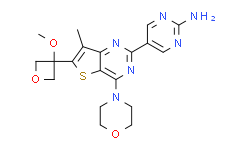| 中文名称: | GNE-317 | ||||
|---|---|---|---|---|---|
| 英文名称: | GNE-317 | ||||
| 别名: | 5-(6-(3-甲氧基氧杂环丁烷-3-基)-7-甲基-4-吗啉基噻吩并[3,2-d]嘧啶-2-基)嘧啶-2-胺 5-(6-(3-methoxyoxetan-3-yl)-7-methyl-4-morpholinothieno[3,2-d]pyrimidin-2-yl)pyrimidin-2-amine | ||||
| CAS No: | 1394076-92-6 | 分子式: | C19H22N6O3S | 分子量: | 414.48 |
| CAS No: | 1394076-92-6 | ||||
| 分子式: | C19H22N6O3S | ||||
| 分子量: | 414.48 | ||||
基本信息
|
产品编号: |
G10773 |
||||
|
产品名称: |
GNE-317 |
||||
|
CAS: |
1394076-92-6 |
储存条件 |
粉末 |
-20℃ |
四年 |
|
|
|
||||
|
分子式: |
溶于液体 |
-80℃ |
6个月 |
||
|
分子量: |
414.48 |
-20℃ |
1个月 |
||
|
化学名: |
5-(6-(3-methoxyoxetan-3-yl)-7-methyl-4-morpholinothieno[3,2-d]pyrimidin-2-yl)pyrimidin-2-amine |
||||
|
Solubility (25°C): |
|||||
|
体外:
|
DMSO |
47mg/mL warmed with 50ºC water bath (113.39mM) |
|||
|
Ethanol |
Insoluble |
||||
|
Water |
Insoluble |
||||
|
体内(现配现用): |
|
||||
|
<1mg/ml表示微溶或不溶。 |
|||||
|
普西唐提供的所有化合物浓度为内部测试所得,实际溶液度可能与公布值有所偏差,属于正常的批间细微差异现象。 |
|||||
|
请根据产品在不同溶剂中的溶解度选择合适的溶剂配制储备液;⼀旦配成溶液,请分装保存,避免反复冻融造成的产品失效。 |
|||||
制备储备液
|
浓度
溶液体积 质量 |
1mg |
5mg |
10mg |
|
1mM |
2.4127mL |
12.0633mL |
24.1266mL |
|
5mM |
0.4825mL |
2.4127mL |
4.8253mL |
|
10mM |
0.2413mL |
1.2063mL |
2.4127mL |
生物活性
|
产品描述 |
一种 PI3K/mTOR抑制剂,能够穿过血脑屏障(BBB)。 |
|
|
靶点 |
PI3K |
mTOR |
|
体外研究 |
GNE-317 is an oxetane derivative of GDC-0980 synthesized with the goal of reducing substrate affinity for efflux transporters.In vitro,GDC-0980 and GNE-317 demonstrate similar profiles in MTS cytotoxicity experiments using the GL261 cell line. |
|
|
体内研究 |
Seven days after i.c.inoculation with GL261-GFP-Luc cells,mice are treated once daily with the maximum tolerated dose of GDC-0980 (7.5mg/kg),GNE-317 (30mg/kg),or vehicle.For GL261,tumor growth is tracked through bioluminescence imaging on a weekly basis.There are no significant changes in GL261 tumor growth among the 3 groups.In assessing survival benefits in GL261,neither GDC-0980 nor GNE-317 provides survival benefit over the vehicle-treated animals.The fact that these drugs are not effective in vivo is suggested by the in vitro cytotoxicity data showing that the drugs have limited efficacy in inducing cell death in the GL261 cell line.Neither drug is effective in the GL261 tumor in spite of greater delivery and enhanced therapeutic targeting efficacy of GNE-317. |
|
推荐实验方法(仅供参考)
|
细胞实验: |
|
|
GL261 is an aggressive C57BL/6J-derived glioma line.This cell line is transfected with both green fluorescent protein (GFP) and luciferase (Luc) from separate plasmids.The resultant monoclonal GL261-GFP-Luc cells are maintained in Dulbecco's modified Eagle's medium supplemented with 10% FBS and Penicillin/Streptomycin (100 U/mL) and cultured at 5% oxygen.Cell selection used 4mg/mL Puromycin and 4mg/mL G418.Cellular viability assays are set up in a 96-well format with 2000 cells plated per well in the culture conditions.Cells are incubated in the presence of drug or vehicle for 48 hours,and viability was assessed by MTS assay.Absorbance at 490nm is used to determine viability and at 650nm to account for background using a Synergy Mx automated plate reader.Numerical values from drug-treated wells are normalized to the values of vehicle-treated wells to yield percent survival. |
|
|
动物实验: |
|
|
Mice GL261-GFP-Luc cells are implanted into 7-week-old C57BL/6J mice.When tumors reach 5e7 photons/s/cm2/sr (radiance),animals are orally administered the maximum tolerated dose of GDC-0980 (7.5mg/kg),GNE-317 (30mg/kg) or vehicle once a day for 3 days.The maximum tolerated doses are defined as the greatest dose that could be administered to mice with<10% drop in bodyweight.Even at these different doses,both doses provide similar plasma concentrations and thus the same overall systemic exposure.At 1 or 6 hours after the third dose,mice are euthanized with carbon dioxide and perfused with 30mL PBS.With the aid of GFP goggles,brains are dissected into tumor core,tumor rim,and normal brain tissue.Tissue samples and blood are processed,and tissue specimens from each group are analyzed for drug concentrations using LC-MS/MS. |
|
本计算器可帮助您计算出特定溶液中溶质的质量、溶液浓度和体积之间的关系,公式为:
质量 (g) = 浓度 (mol/L) x 体积 (L) x 分子量 (g/mol)
摩尔浓度计算公式
用本工具协助配置特定浓度的溶液,使用的计算公式为:
开始浓度 x 开始体积 = 最终浓度 x 最终体积
稀释公式
稀释公式一般简略地表示为:C1V1 = C2V2 ( 输入 输出 )








